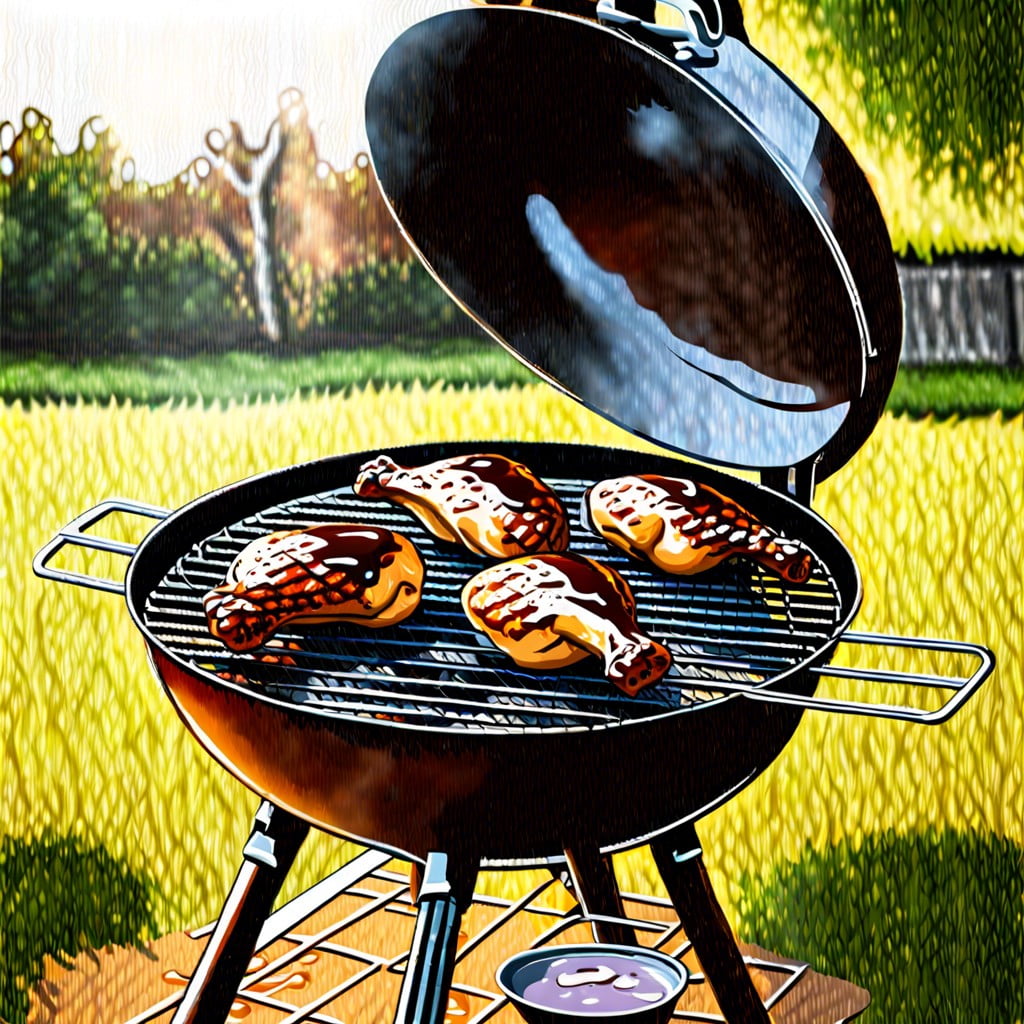Grilling the perfect BBQ chicken involves mastering both temperature control and flavor enhancement—the following tips will guide you through the process.
Key takeaways:
- Achieving the perfect grilled BBQ chicken requires temperature control.
- Bone-in cuts insulate the meat and promote even cooking.
- Start with indirect heat and finish with direct heat for a crispy exterior.
- Apply BBQ sauce during the last 10 minutes of cooking.
- Complement BBQ chicken with grilled vegetables, coleslaw, cornbread, potato salad, baked beans, and watermelon.
The Trick To Good Grilled BBQ Chicken

Achieving the perfect grilled BBQ chicken is a matter of balancing heat, timing, and seasoning. Uniform thickness in your chicken pieces ensures even cooking.
Indirect grilling is a go-to technique; it allows chicken to cook thoroughly without burning the exterior. Low and slow is typically recommended for optimal tenderness and moisture retention.
Heat regulation is paramount – too high and you risk charred skin, too low and your chicken could become rubbery. A good instant-read thermometer is your ally in hitting the sweet spot of 165°F internally.
Always rest your chicken before serving to let the juices redistribute, this avoids a dry texture. Marinate or brine ahead of time for depth of flavor and added juiciness, but take care not to let sugary marinades burn on the grill.
Finally, keep a watchful eye and a steady hand; vigilance ensures perfection on the plate.
Best Cuts for BBQ Chicken
When selecting cuts for grilling, consider the bone-in options – breasts, thighs, drumsticks, and wings. The bone insulates the meat, promoting even cooking and retaining juiciness. Boneless skinless breasts, though popular, can easily dry out if overcooked. Thighs, with more fat content, are forgiving and flavorful, while drumsticks provide a perfect hand-held option. Wings, smaller and faster to cook, are ideal for feeding a crowd.
For a balanced experience, mix different cuts, adjusting grill time accordingly to ensure each reaches the appropriate internal temperature – 165°F for breasts and wings, and slightly higher for darker meats like thighs and drumsticks.
Method
Starting with indirect heat is crucial. Arrange your grill for two zones: a hot side for searing and a cooler side for slower cooking. Place seasoned chicken pieces, skin-side up, on the cooler side, cover with the grill lid, and let them gently come up to temperature. This method ensures that the chicken cooks through evenly, reducing the risk of dried out breast meat or undercooked thighs.
Once the internal temperature nears 165°F for breasts and 175°F for thighs, transfer the pieces to the direct heat zone. Sear them briefly, skin-side down, to achieve a golden, crispy exterior. This step adds the tantalizing char and concentrated flavor that’s synonymous with great BBQ.
To infuse smoky flavor, hardwood chips like hickory or applewood can be added to coals or a smoker box if using a gas grill. Keep the lid closed as much as possible to encapsulate the chicken in the smoky atmosphere.
Throughout the grilling process, resist the urge to constantly turn or poke the chicken. Turning only once or twice is sufficient. Continual flipping can cause uneven cooking and loss of juices, making the meat tough and less flavorful.
When to Put BBQ Sauce On Grilled Chicken
Slathering sauce onto the chicken too early is a common pitfall. Begin grilling your chicken without sauce, allowing it to develop a nice sear and reach an internal temperature of about 165 degrees Fahrenheit for breasts and 175 degrees Fahrenheit for thighs and drumsticks. Typically, this can be during the last 10 minutes of cooking time.
Applying barbecue sauce at this stage prevents burning the sugars in the sauce — a result of too much direct heat — which can impart a bitter flavor. Brush the sauce on in layers, turning the chicken regularly to ensure an even coating that adheres properly, building up a delectable glaze that’s caramelized, not charred.
What Sides Are Good With BBQ Chicken
Selecting the perfect accompaniments can elevate your BBQ chicken to a full, satisfying meal. Balance is key; aim for sides that complement the smokiness and richness without overwhelming the palate.
- Grilled Vegetables: The char marks from grilling vegetables add a complementary smokiness that pairs well with BBQ chicken’s flavor.
- Coleslaw: The crispness and tang of the coleslaw provide a refreshing contrast to the savory, slightly sweet notes of the chicken.
- Cornbread: Its subtle sweetness and buttery texture act as the perfect sponge for BBQ sauce.
- Potato Salad: Choose a version with a mustard or vinegar-based dressing to cut through the richness of the BBQ sauce.
- Baked Beans: Their hearty, sweet, and tangy profile serves as both a side and sauce enhancer.
- Watermelon: A slice of watermelon provides a juicy and crisp finish, cleansing the palate.
Strive for diversity in texture and flavor to keep each bite of your BBQ chicken meal interesting and well-rounded.

